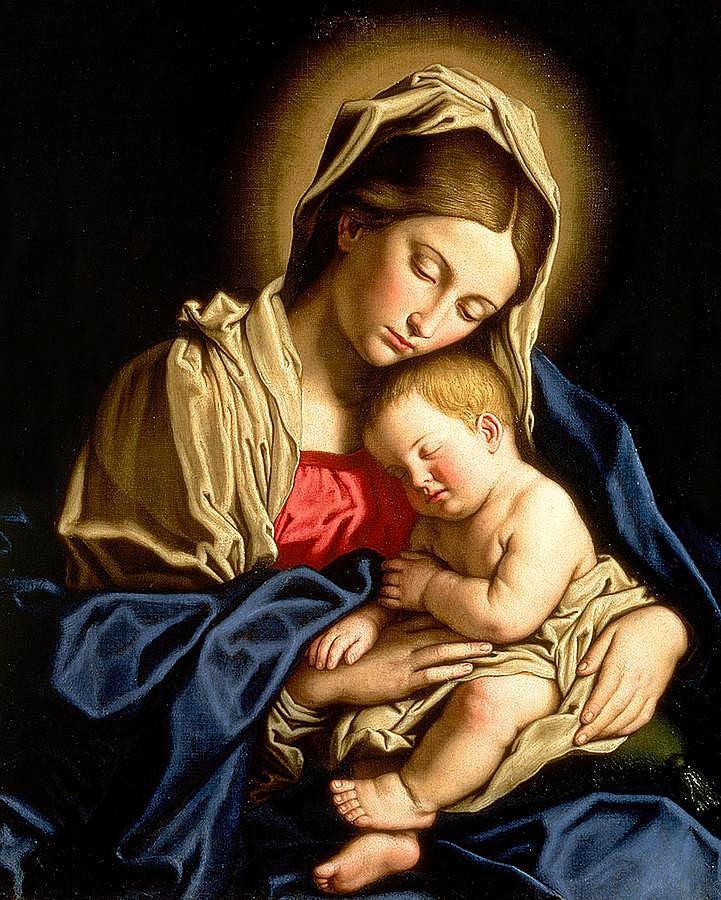Description
The Madonna and Child was one of Sassoferrato's most popular compositions, and was reproduced by him many times, to consistently high quality, also in horizontal and oval format, inverted, and with the Virgin depicted in Glory and assisted by angels.
Sassoferrato was eclectic and copied or adapted compositions dating from the 14th century to the contemporary; his favorite masters were Raphael, Titian, and Guido Reni, but he also borrowed works by Joos van Cleve, Dürer, Mignard, and many others. Our composition depends on an engraving by Guido Reni made around 1615-1625, repeated in several variants with different drapes and gestures, and later popularized by numerous copies.
Sassoferrato's reputation in 17th-century art rests almost entirely on his paintings of the Madonna, executed with remarkable simplicity of color and composition, almost entirely without background settings or references to Baroque or Classical forms. His genius lies in capturing a vision of the Virgin of such exquisite beauty and devotion that they distinguish him from any other contemporary. The same face appears with few variations in most of his minuscule production and will be imitated by successive generations of painters.
Giovanni Battista Salvi was born in Sassoferrato in 1609. His father was a local painter named Tarquinio, with whom he received his first training. As a young man he had to travel to the border areas of the Marches, such as Umbria and Perugia, where from 1630 he was employed by the Benedictine Convent of S. Pietro for which he produced a series of ten saints for the sacristy ceiling. of your church. Although clearly influenced by other artists of the Bologna school, such as Guido Reni and Guercino, tradition has it that he studied in Rome and Naples with Dominichino, who had left Rome for Naples in 1631. It is to this master that he owes the pronounced clarity, the refinement and idealized beauty that influenced her highly individualistic style.
The first documentary evidence of Sassoferrato's presence in Rome does not come until 1641, when he executed a painting for the Church of San Francesca di Paola. The following year, Princess Pamphili di Rossano commissioned him to paint one of his best-known paintings, Our Lady of the Rosary, for the Church of Santa Sabina. At the time of his marriage, in 1648, he lived in the Roman parish of San Salvatore ai Monti, the artists' quarter, but for the next thirty years there is no further documentary evidence of his whereabouts, nor any of his paintings. signed or dated.
Presumably during this time he worked on the production of the many images of the Virgin for which he became famous. The fashion for such images, stimulated by the Marian cult fostered by the Counter-Reformation, forced him to paint them in quantity and to maintain a reserve stock to meet the ever-increasing demand. Despite the large number of such images, each one reveals a consistently high quality of execution. In each work he demonstrates his painstaking craftsmanship and skillful use of bright color.
In this painting, the Virgin gently cradles the sleeping Child Jesus in her arms. With his rosy cheeks and chubby arms and legs, the Christ Child appears like a typical healthy baby. Maria is shown as a radiant young mother. This image endows the Virgin and Child with human qualities and celebrates the natural maternal bond between mother and child. This link is emphasized in the way Mary embraces Jesus, resting her cheek on his head. Here the coloring is simple yet brilliantly vibrant.
The rich, warm golds and pinks and the soothing blue of Maria's shawl lend peace and tranquility to the composition. Sassoferrato's crisp, clean lines, exemplified by the finely executed drapery folds, reveal his mastery of classical Baroque painting techniques. Such painstaking craftsmanship contributed to its popularity.

